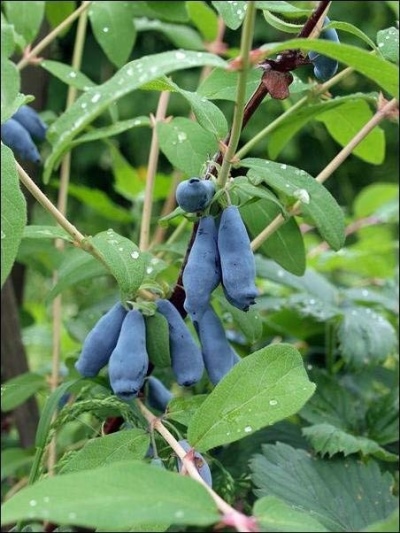
- Authors: M.N. Plekhanov, A.V. Kondrikova (Vavilov All-Russian Institute of Plant Genetic Resources)
- Year of approval: 2002
- Growth type: medium-sized
- Escapes: thin, straight, light green, with a slight anthocyanin, densely pubescent, strongly leafy
- Leaves: medium, green, elongated-oval, concave
- Crown: reverse conical, thick
- Fruit size: large
- Fruit weight, g: 0,92
- Fruit shape: medium, fusiform, tuberous
- Fruit color: bluish blue
For a long time, honeysuckle was planted in the garden only for decorative purposes, but thanks to the work of scientists, an edible variety has appeared that replenishes the human body with useful vitamins and microelements. A popular edible variety is the Nightingale honeysuckle.
Breeding history
The nightingale appeared thanks to the efforts of scientists from the All-Russian Research Institute of Plant Genetic Resources. N.I. Vavilov in 2001. The authors of the Nightingale variety are the breeders M.N. Plekhanova and A.V. Kondrikova. A berry crop was bred by crossing the Pavlovskaya variety with edible honeysuckle from Primorye. Included in the register of approved for use since 2002. Honeysuckle is cultivated in all climatic zones.
Description of the variety
Berry culture Nightingale is a medium-sized shrub endowed with a reverse conical crown shape, which is abundantly thickened with light green oval-elongated leaves. The neat bush has thin, upright shoots with a dense edge and a developed root system.
The flowering of the bush begins in late April - early May. The compact crown of the bush is covered with large light-colored flowers, which attract insects with a bright aroma.
Fruit characteristics
Honeysuckle is a large-fruited variety. On an adult shrub, berries grow weighing 0.92 grams. The shape of the berries is unusual, outwardly resembling a spindle. The peel of the berries is of medium density, with pronounced tuberosity and a bluish bloom. Ripe berries are beautifully covered with a bluish-blue color. The berries hold on to the shortened stalks, without crumbling even in strong winds and being a little overripe.
The purpose of the berries is universal - they are useful fresh, they are processed into jams, fruit drinks, compotes, frozen, dried. Thanks to the strong shell (skin), the berries can easily be transported. The harvest is stored for 4 days, but if you keep the honeysuckle in the refrigerator, the keeping quality will last up to 7-10 days.
Taste qualities
The nightingale is famous for its good taste. The flesh of the berries is tender, fleshy, juicy. The taste is dominated by pleasant sourness, which is complemented by dessert sweetness. The aroma of the fruit is light, but very pleasant, refreshing.
Ripening and fruiting
Medium early honeysuckle begins to bear fruit in the 3rd year after planting. The fruits are ripened in stages - first the top of the bush, and then the middle and lower part. Due to the fact that the fruits do not crumble, they can be removed at once. You can taste the first berries in the third decade of June. The peak of fruit recoil starts from the end of June - the beginning of July and lasts for a long period.
Yield
The variety is characterized by a decent yield. If you provide the plant with proper care, then it will certainly thank you with a good harvest. Up to 2.5 kg of useful berries can be removed from 1 bush. Growing a crop on an industrial scale, an average of 42 quintals of honeysuckle is harvested from 1 hectare of plantations.

Self-fertility and the need for pollinators
The nightingale, like other types of honeysuckle, cannot do without the help of donor bushes, since it is self-fertile. Effective pollinating varieties will be: Malvina, Blue Spindle, Start, Morena, Blue Bird. For full pollination, the distance between plantings should not exceed 15 meters.
Growing and care
The seedling is planted in the fall (late September - early October). Two-year-old seedlings are the most successful. It is recommended to plant bushes in an area where potatoes or cucumbers previously grew.
Berry agricultural technology includes a number of simple measures: regular watering, fertilizing from the third year of growth, shaping bushes, removing dry and damaged branches, weeding and loosening the soil, preventing viruses and pest attacks, preparing for winter.


Disease and pest resistance
The variety has strong immunity, so the plant is able to withstand many fungal and bacterial infections. Against the background of unfavorable weather conditions, the shrub may develop brown and gray spotting, as well as powdery mildew.

Winter hardiness and the need for shelter
Honeysuckle has a high cold resistance, therefore it easily survives frosts down to -40 ... 45 degrees. It should be noted that the root system and flower buds can also withstand temperatures of -35 ... 40. Adult bushes do not need shelter. The exception is young seedlings that need to be covered for the winter. Dry foliage or burlap is used as a covering material.
Location and soil requirements
Honeysuckle Nightingale loves light, warmth, moderate moisture and air, so it feels comfortable in the southern part of the garden, where there is a lot of sun, and there is also reliable protection from the north wind and drafts. For the cultivation of a useful crop, a fertile loamy and sandy loam soil with neutral acidity and deep groundwater is selected.
































































